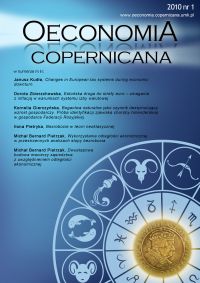Two-Stage Procedure Of Building A Spatial Weight Matrix With The Consideration Of Economic Distance
DOI:
https://doi.org/10.12775/OeC.2010.004Keywords
spatial econometrics, spatial data, matrix, economic distanceAbstract
The article discusses an essential problem of spatial econometrics which is the construction of a spatial weight matrix. This matrix expresses potential spatial interactions between the researched areas and forms the basis for spatial analyses. The objective of the paper was to consider various ways of defining the a spatial weight matrix. Consideration was given to the methods of identifying adjacency between areas in the form of neighbourhood in the sense of a common border, the adjacency identified on the basis of the physical distance and on the criterion of the k number of the nearest neighbours. Also, the issue of identifying the force of impact for the previously defined neighbourhood system was taken into account. The approaches that were considered include the standardisation of matrices by rows to unity, or the identification of the force of impact based on the physical properties of areas. The outcome of the considerations is the proposed two-stage procedure of building a spatial weight matrix. A definition of economic distance was proposed, the definition which constitutes an adequate instrument for measuring the force of interaction between neighbouring areas. The introduced economic distance is an important alternative to the identification of the force of impact of economic spatial processes in relation to the distance based on the physical properties of the researched areas and in relation to the proposal of the standardisation by rows to unity.References
Anselin L. (1988), Spatial Econometrics: Method and Models, Kluwer Academic Publishers, Netherlands.
Anselin L., Florax R. J. G. M., Rey, S. J. (2004), Advances in Spatial Econometrics. Methodology, Tools and Applications, Springer-Verlag, Berlin.
Arbia G. (2006), Spatial Econometrics, Springer-Verlag GmbH.
Bivand R. (1981), Modelowanie geograficznych układów czasoprzestrzennych, PWN, Warszawa-Poznań.
Bivand, R., S., Pebesma, E. J., Gómez-Rubio, V. (2008), Applied Spatial Data Analysies with R, Springer, New York.
Clif A., Ord J. (1973), Apatial Autocorrelation, Pion, London.
Clif A., Ord J. (1981), Apatial Processes, Models and
Applications, Pion, London.
Cressie N. A. C. (1993), Statistics for Spatial Data, John Wiley & Sons, New York.
Geary R. (1954), The contiguity ratio and statistical mapping, “TEhe Incorporated Statistician, 5, s. 115-145.
Getis A., Mur, J. Zoller, H. (2004), Spatial Econometrics and Spatial Statistics, Palgrave Macmillan.
Haining R. P. (2005), Spatial Data Analysis. Theory and Practice, Cambridge University Press, 3rd ed., Cambridge.
Klaassen J. H. P., Paelinck L. H., Wagenaar S. (1982), Systemy przestrzenne, PWN, Warszawa.
Klaassen J. H. P., Paelinck L. H. (1983), Ekonometria przestrzenna, PWN, Warszawa.
Kopczewska K. (2006), Ekonometria i statystyka przestrzenna, CeDeWu, Warszawa.
LeSage J. P., Pace R. K. (red) (2004), Advances in Econometrics: Spatial and Spatiotemporal Econometrics, Elsevier, Amsterdam.
LeSage J.P., Pace R. K. (2009), Introduction to Spatial Econometrics, CRC Press.
Moran P. (1948), The interpretation of statistical maps, „Journal of the Toyal Statistical Society”, Series B,10, s. 243-251.
Pietrzak M. (2009), Analiza danych przestrzennych a jakość informacji, „Modelowanie preferencji a ryzyko ’09”, T. Trzaskalik (red.), AE Katowice, 2009, s. 323-339.
Pietrzak M. (2010), Problem identyfikacji struktury danych przestrzennych, „Acta Universitatis Nicolai Copernici, Ekonomia XLI”, Wydawnictwo UMK, w druku.
Schabenberger, O., Gotway, C. A. (2005), Statistical Methods for Spatial Data Analysis, Texts in Statistical Science, Chapman & Hall/CRC, Taylor &Francis Group, Boca Raton, London.
Suchecki B. (2010), Ekonometria przestrzenna. Metody i modele analizy danych przestrzennych, Wydawnictwo C.H.Beck, Warszawa.
Szulc E. (2007), Ekonometryczna analiza wielowymiarowych procesów gospodarczych, Wydawnictwo UMK, Toruń 2007.
Zeliaś A. (red) (1991), Ekonometria przestrzenna, PWE, Warszawa.
Downloads
Published
How to Cite
Issue
Section
Stats
Number of views and downloads: 304
Number of citations: 0



